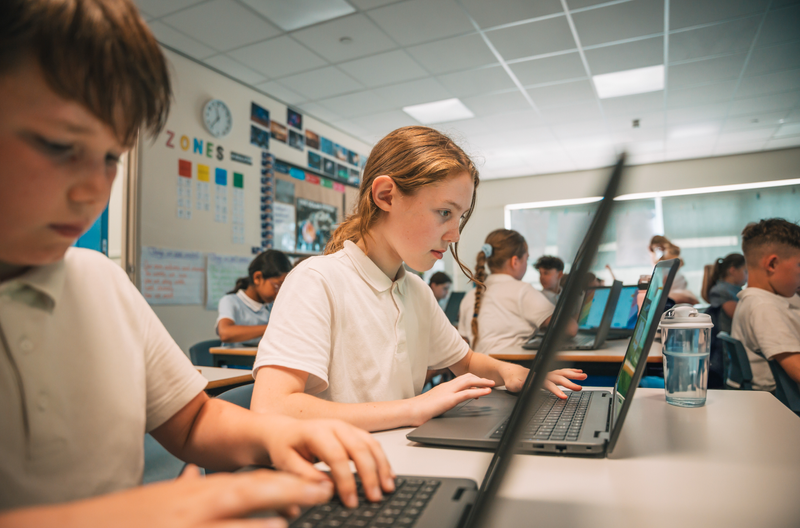At East Ardsley Primary Academy we believe that computing is an integral part of the curriculum; providing our children with essential skills and knowledge to succeed in a world that is consumed by technology. As a school we aim to ensure that all our children leave with a strong foundation knowledge in computing, to build on throughout their academic journey. Technology has had a profound impact on our ever-advancing society and, moving forwards, is becoming an increasingly vital part of our everyday lives.
Communication has also become increasingly based around ICT: email, faxes, voice mail, audio and video conferencing, chat rooms, shared documents, and virtual workspaces are all examples of these. Children at East Ardsley are introduced to some of these methods (email, blogging, audio recording, shared documents), whilst continuously modelled their importance and effectiveness through platforms such as Tapestry – a tool to keep our teachers, parents and their child’s learning all connected.
Technology has the incredible ability to take learning beyond the four walls of the classroom that without it would be inaccessible, such as being immersed in an incredible virtual reality world of the polar ice caps during an Extreme Places topic, or experiencing the breath-taking moment that a volcano erupts, whilst remaining in the safety of school. We also use technology to expand learning horizons, as our assistive/adaptive ICTs reduces the barriers to participation for children with special physical or learning needs and helps to engage our children in self-directed exploration, as often it can be tailored to children’s individual needs. At East Ardsley we use assessment software in a fun and interactive way, like Accelerated Reader, Big Maths, Time Tables Rock Stars and Digi Maps – which children enjoy using, but which also provides our teachers with the knowledge of child’s learning gaps or ability to work independently which can then be acknowledged and addressed.
Our teaching of computing enriches the curriculum as it promotes pleasure in learning by enhancing children’s engagement, motivation and the desire to learn. This can be through providing unique opportunities for scaffolding and supporting learning for children with special educational learning needs, and children from culturally or linguistically diverse backgrounds. Alternatively, focusing on real-world problems such as sustainability helps to engage our students, as we bring the technology that students use in their daily lives into the classroom and connect what they learn with real-life careers to make their learning more meaningful. This can be achieved by inviting experts into the classroom or Skyping them in order to fill in the gaps of the teachers’ knowledge, make a learning experience have more purpose or link their learning to the wider world. Through this kind of learning children learn more about other cultures, careers and expertise than their one teacher could ever possibly teach them. Through utilising everyday technologies and making use of local locations, we provide students with a rich learning experience where every day they are inspired, learn something totally new and prepare them for the real world after school.
At East Ardsley the Computing curriculum has been carefully mapped out to ensure a wide coverage of the subject and that skills are being revisited and built on each year – this has been split up into 5 main sections: Internet Safety, Programming and Algorithms, Using Computer Networks, Using Technology, and Using Software – which are all taught by the class teacher. Internet Safety is taught across school using “Internet Legends”, a scheme created by Google to help children become safe and confident explorers of the online world. In Programming and Algorithms, the children start away from technology in an “unplugged” format, such as follow direction/instruction cards to create algorithms in real life. After this we apply these skills to exploring a coding programme (Scratch Jr), leading onto completing more complicated and detailed design briefs using the programmes Scratch and Python Coding. In order to use computer networks, children will be taught and become increasingly confident with how to find, save and retrieve their work – moving onto creating, editing and publishing webcasts and blogs. To use technology, children will initially create digital art which they can reflect on, then look at the effectiveness of search engines, as well as beginning to recognise whether a website is reliable. Children are exposed to a range of software programs throughout school and shown how to use them carefully and effectively. These programs include, but are not limited to: Word, Publisher, Powerpoint, Stop Motion, Excel and Pivot Animation.
In most year groups, Computing is taught explicitly in blocks as part of topic sessions and, when appropriate, is linked to the current topic that the children are learning about. However, Computing is often taught and explored indirectly in several other formats which form part of daily lessons. Some examples of this may include: using an online thesaurus to improve vocabulary choices, researching about a person/place/event to increase knowledge before a writing task, or creating visually appealing posters to display learnt or important information. Computing lessons are taught by class teachers, but all members of staff are encouraged to use it within the delivery of each lesson to create a more creative, engaging and immersive learning experience.





